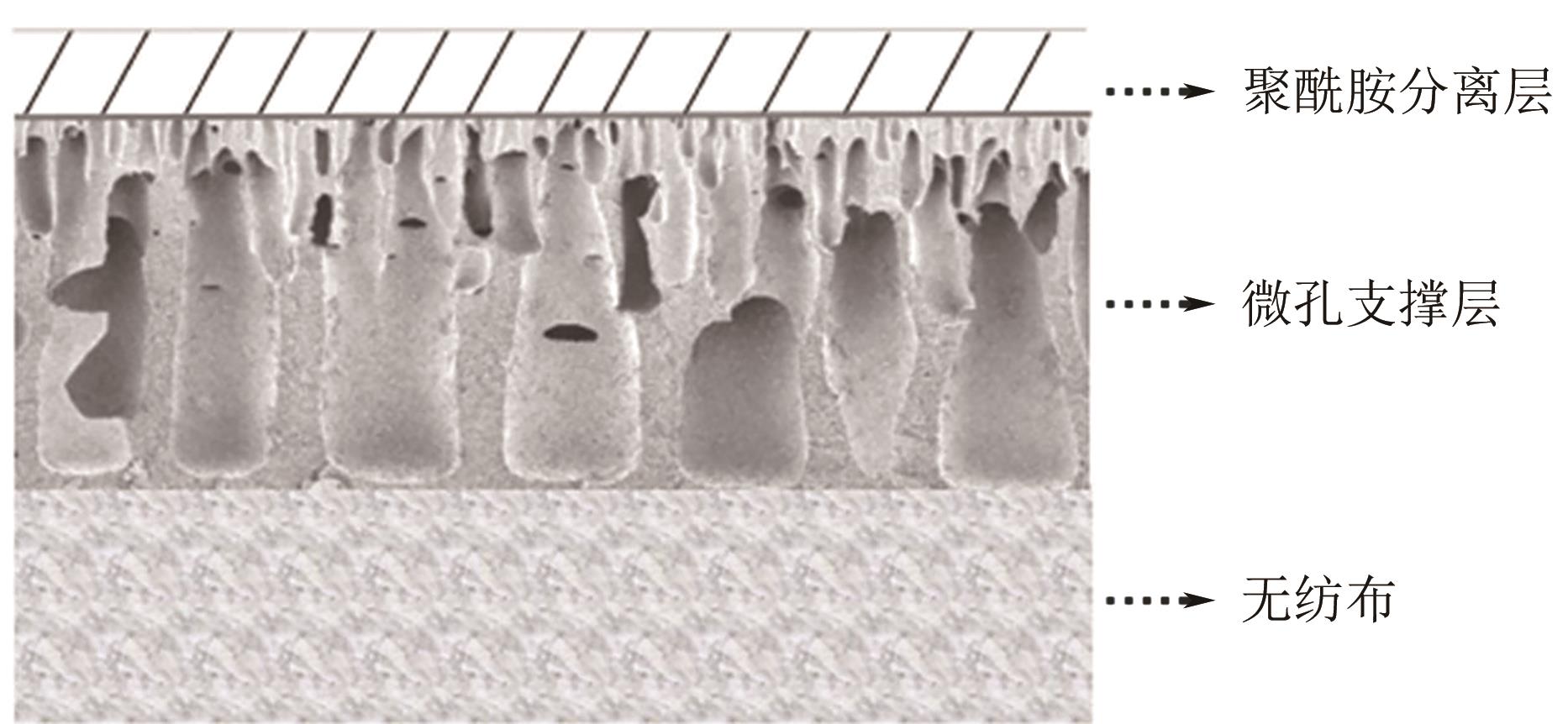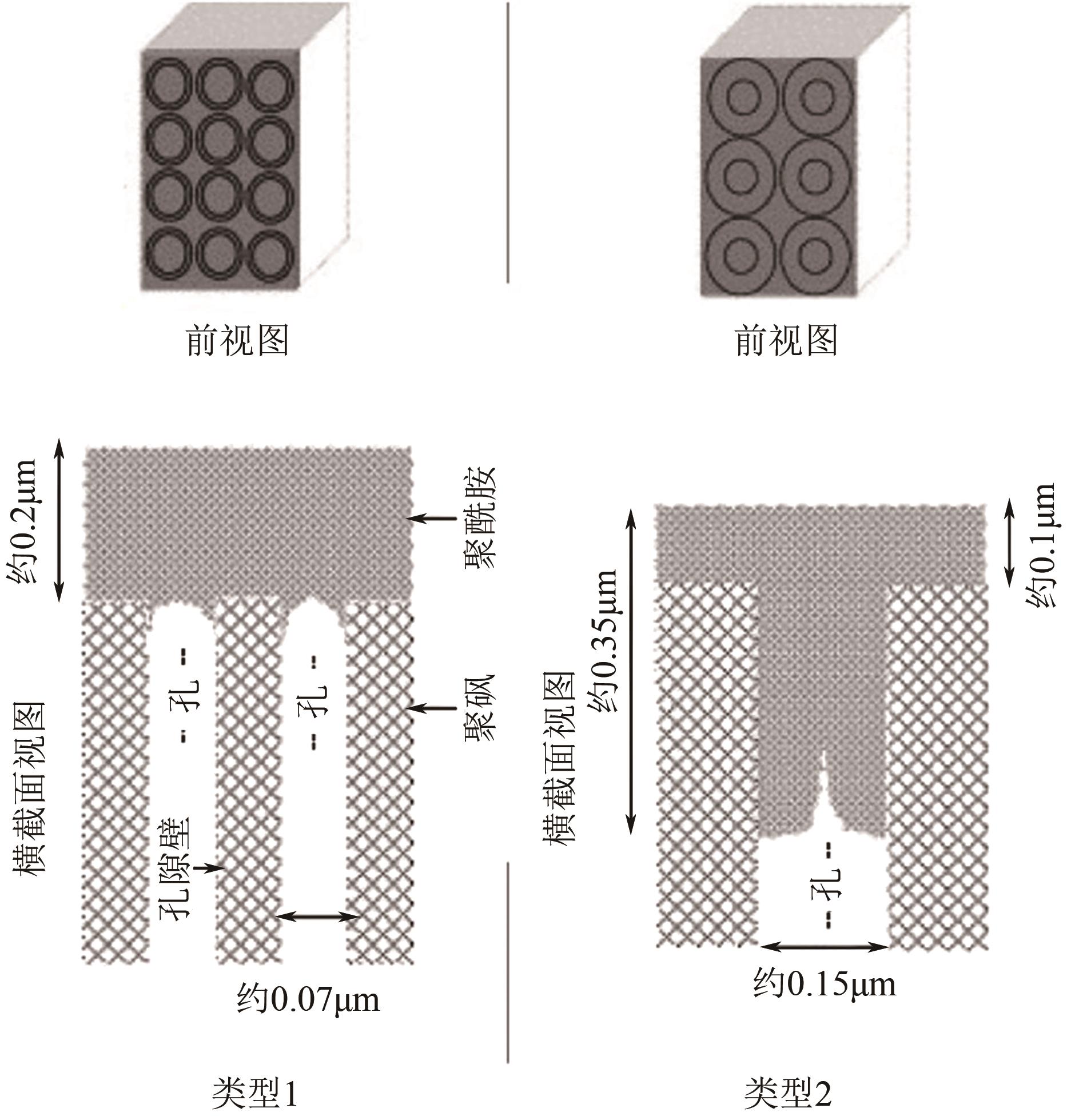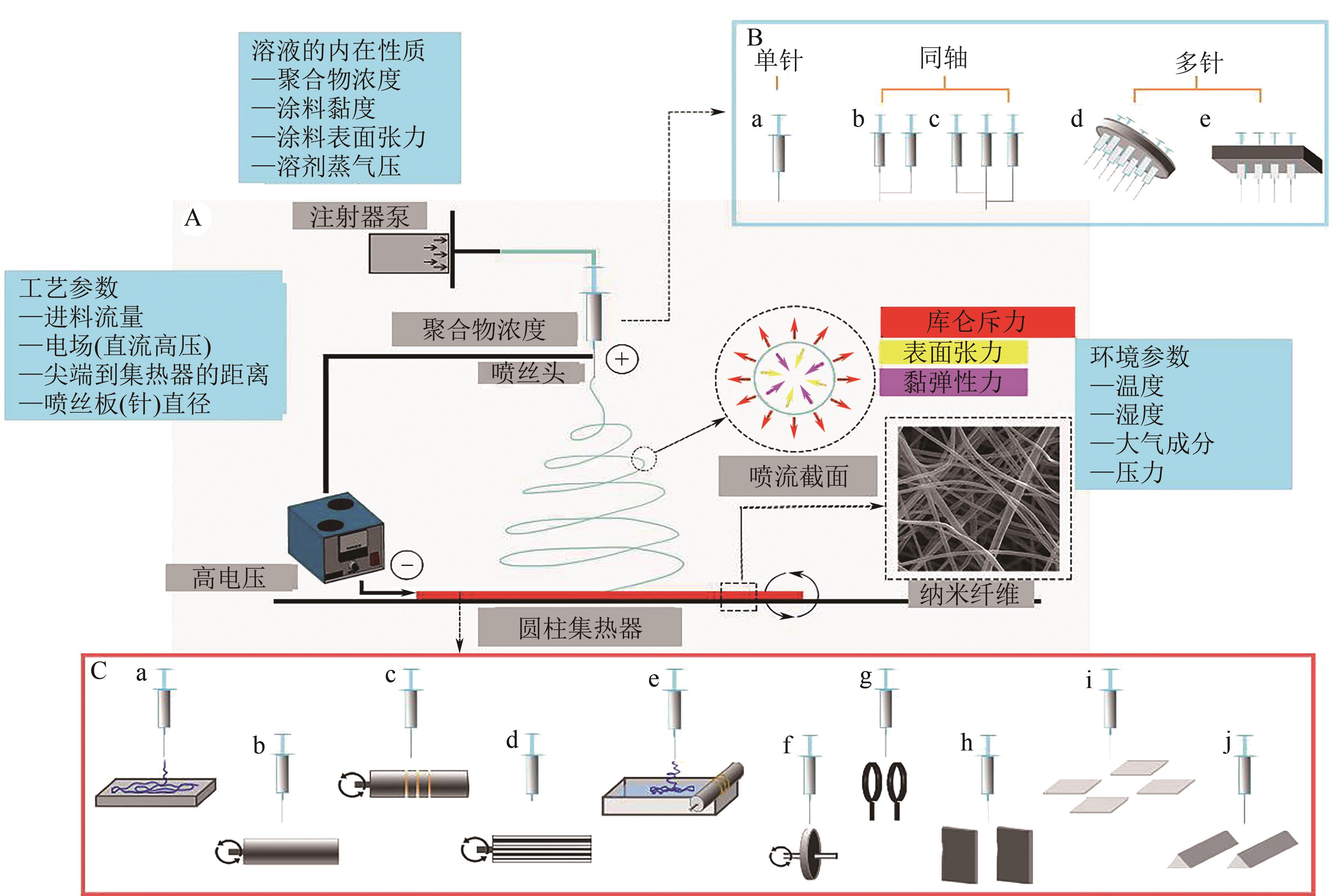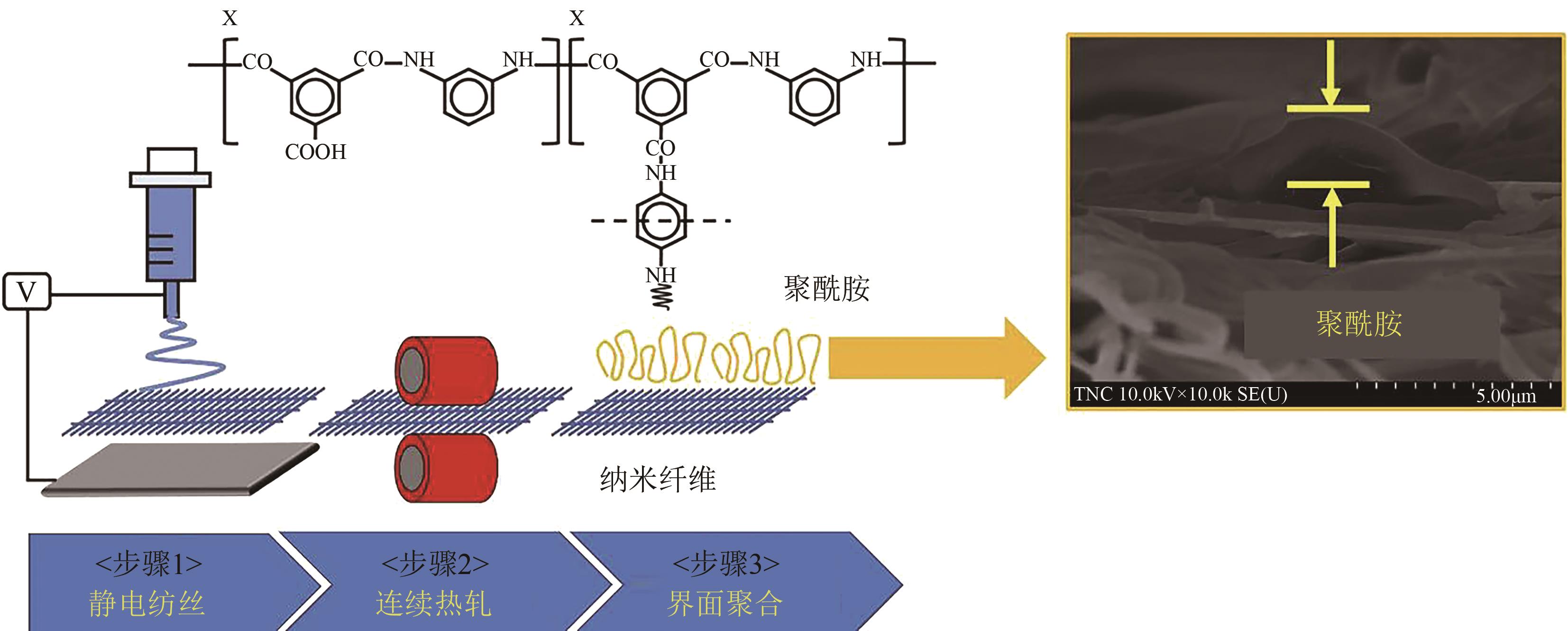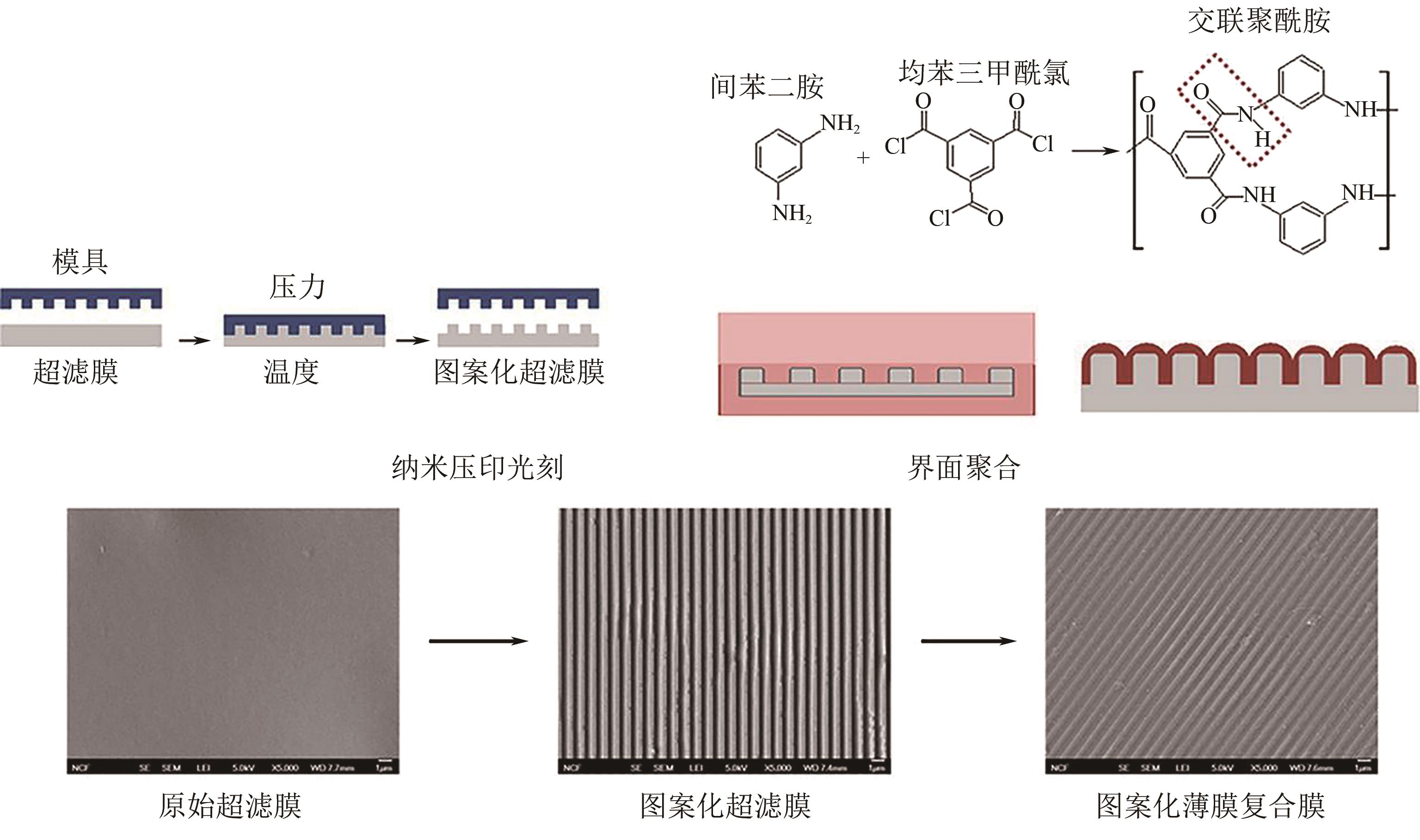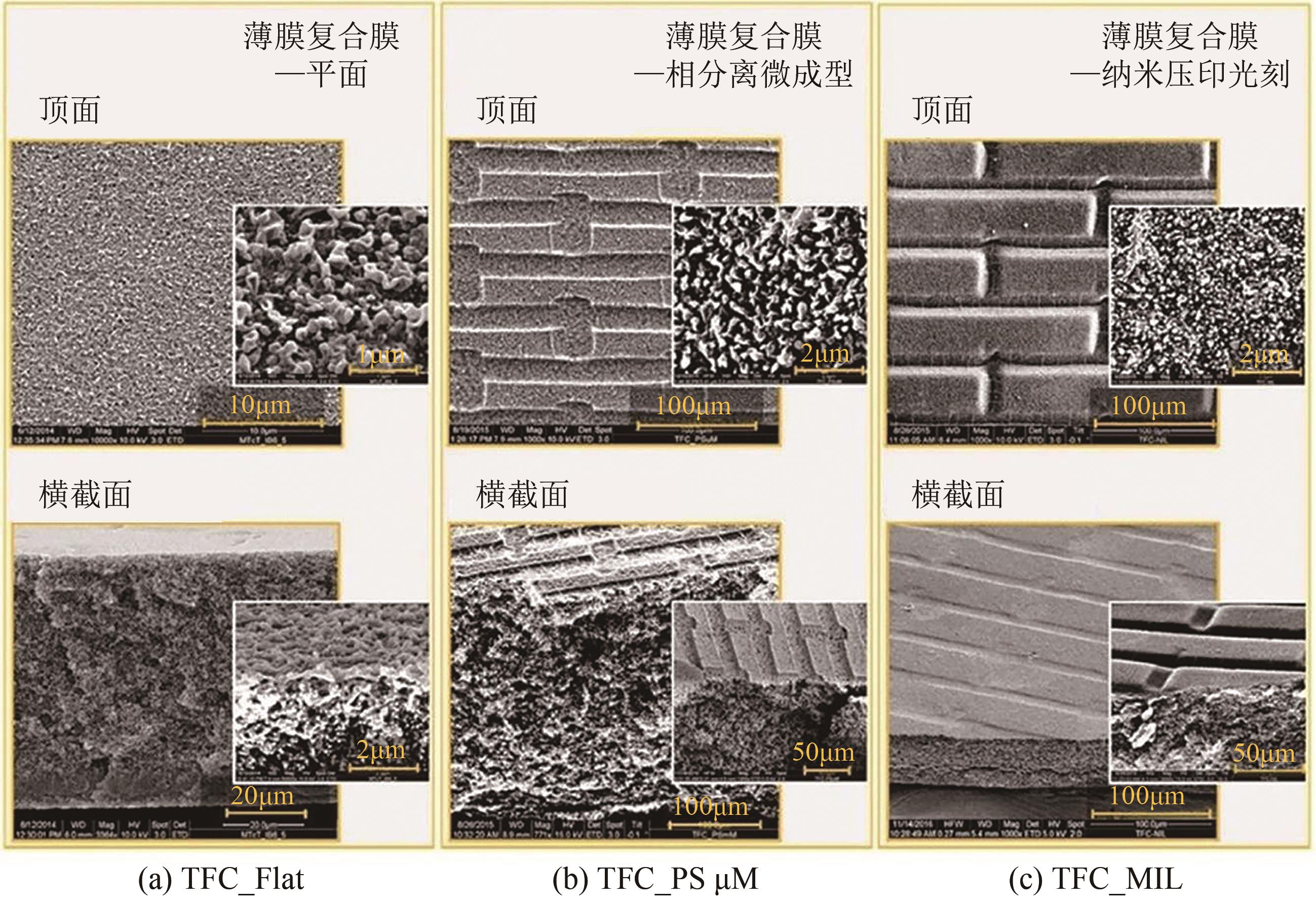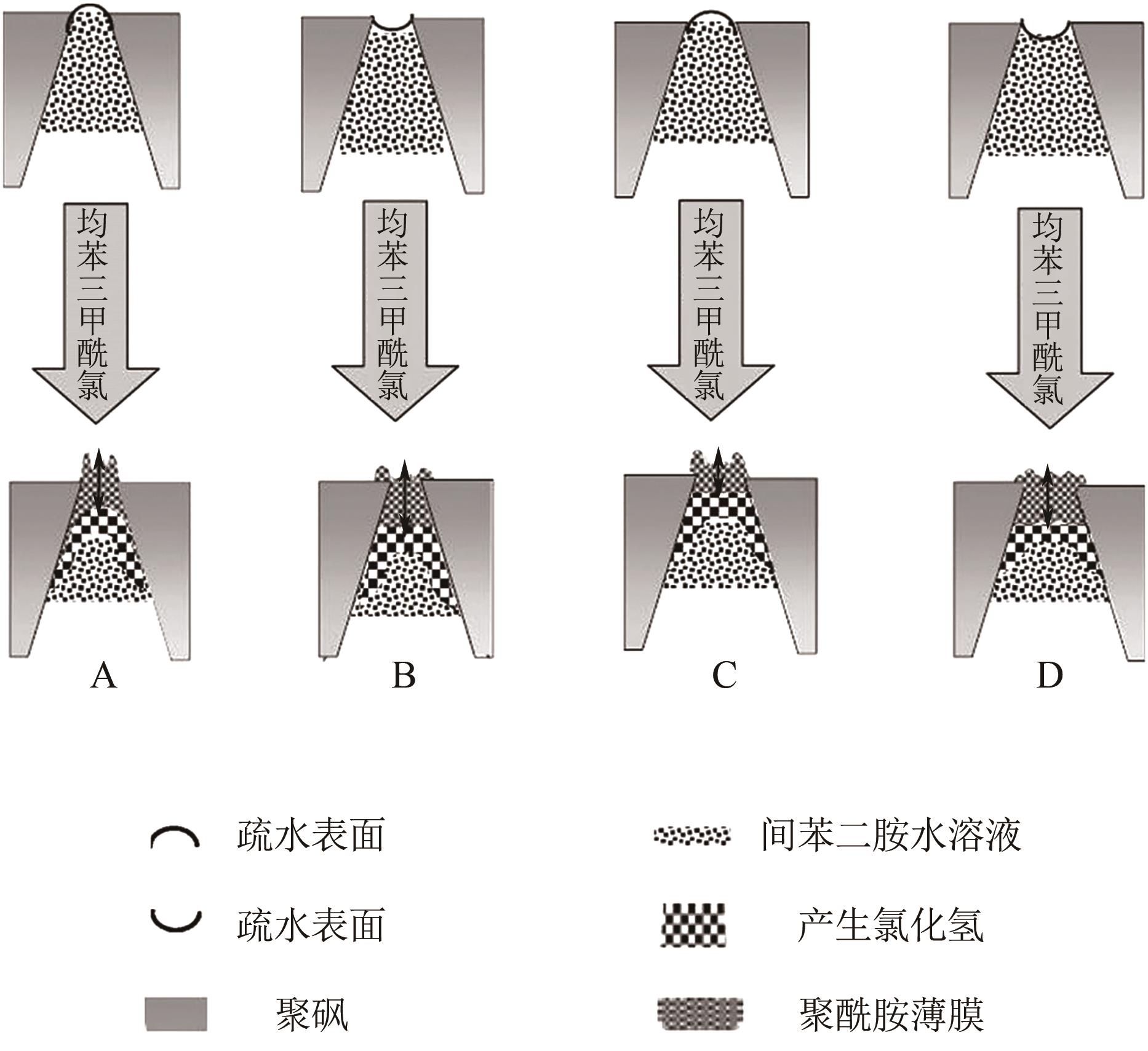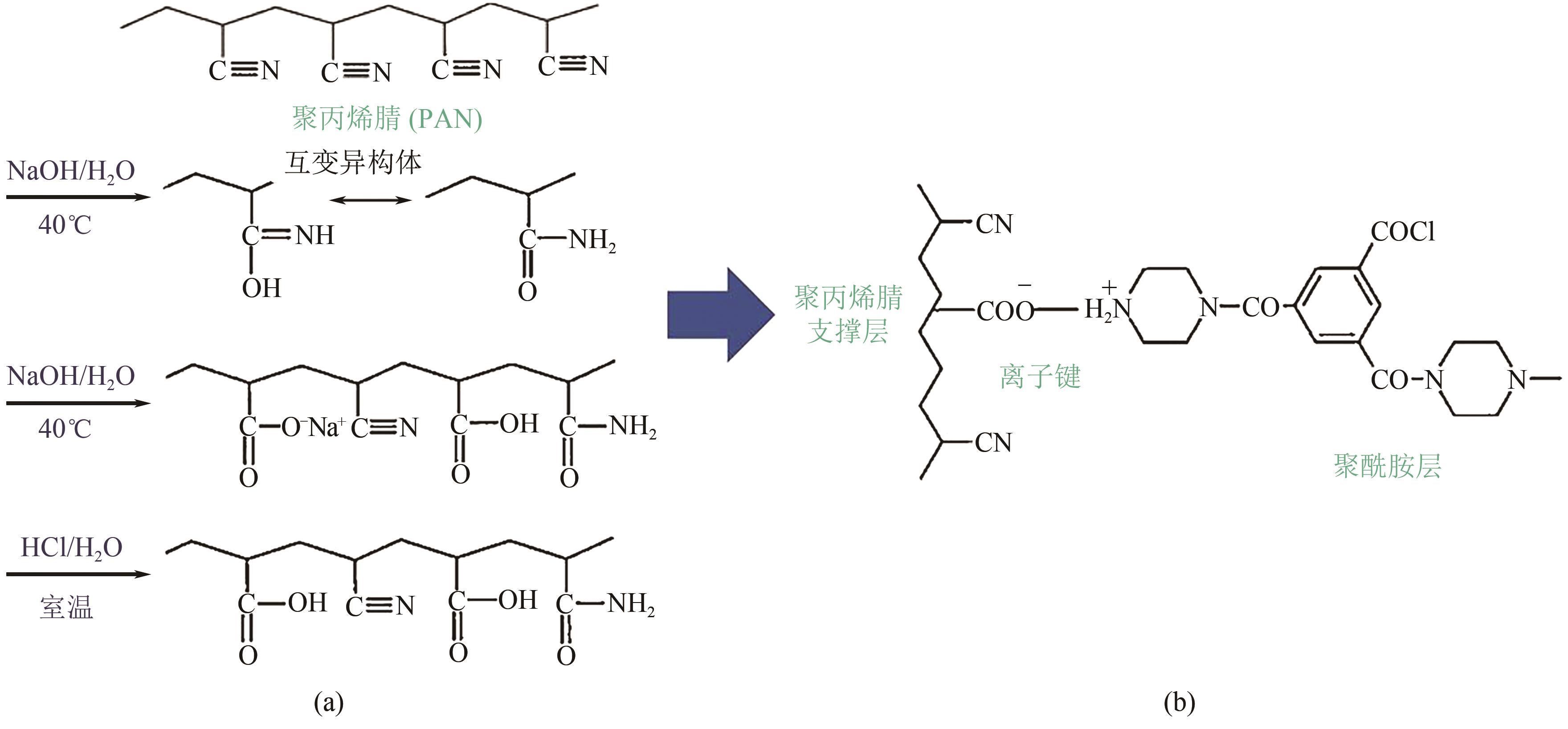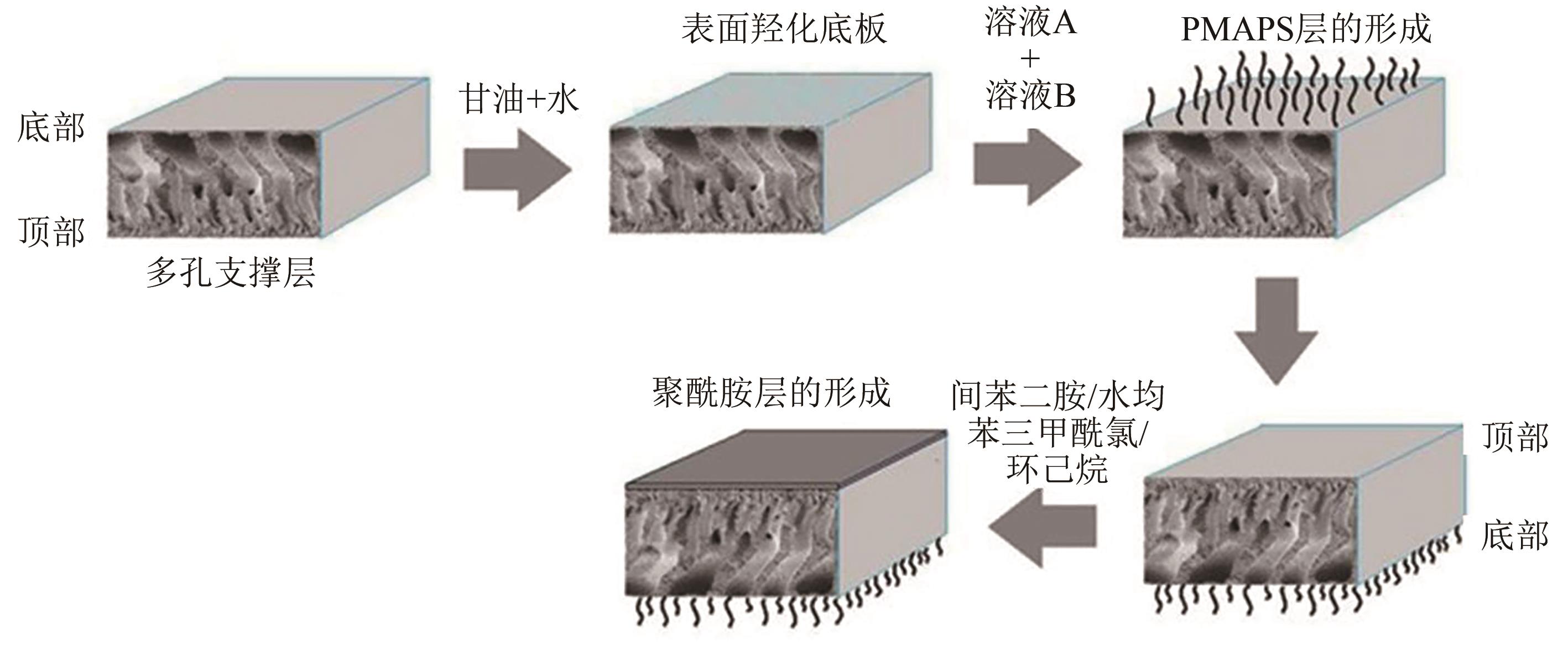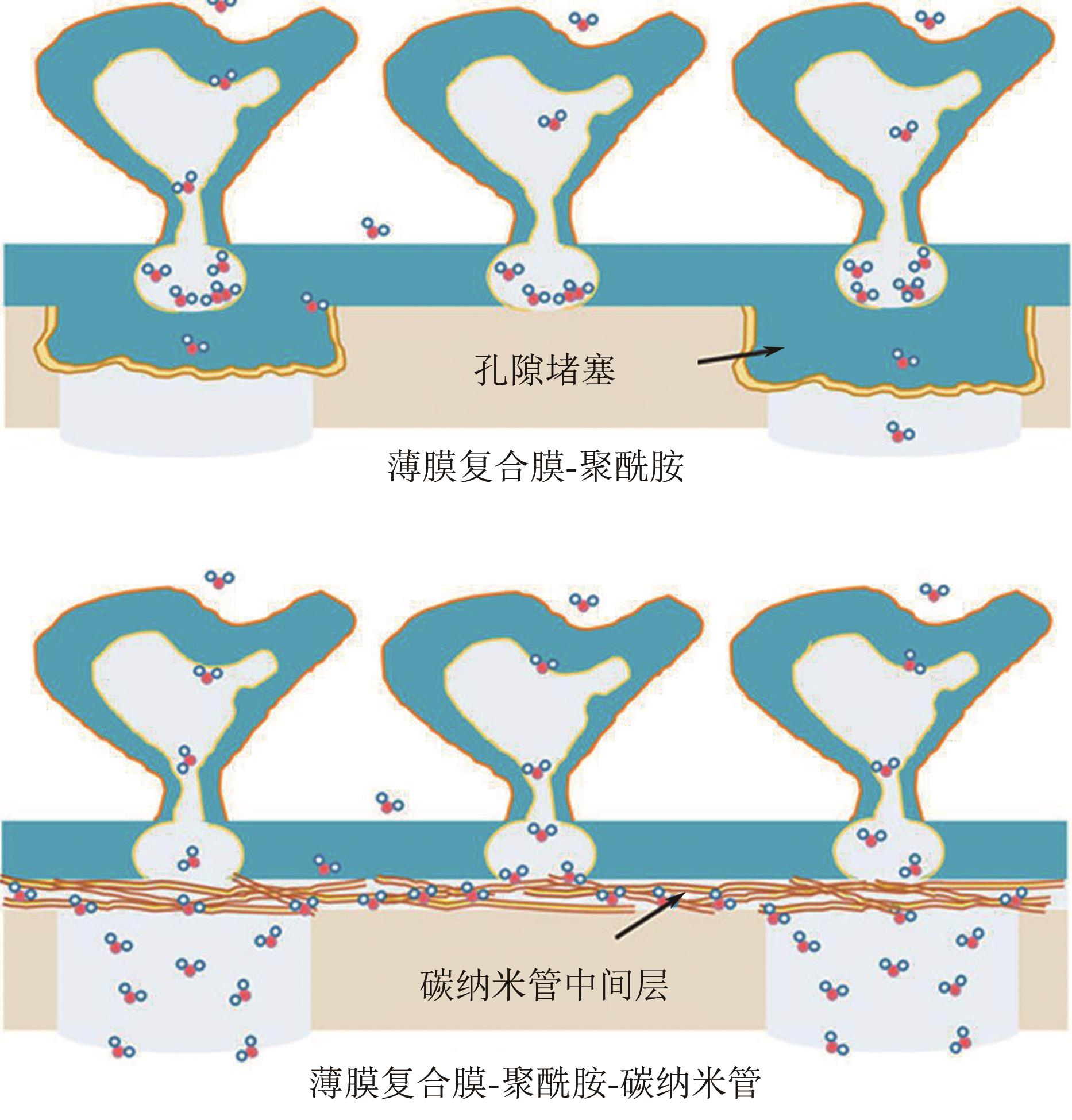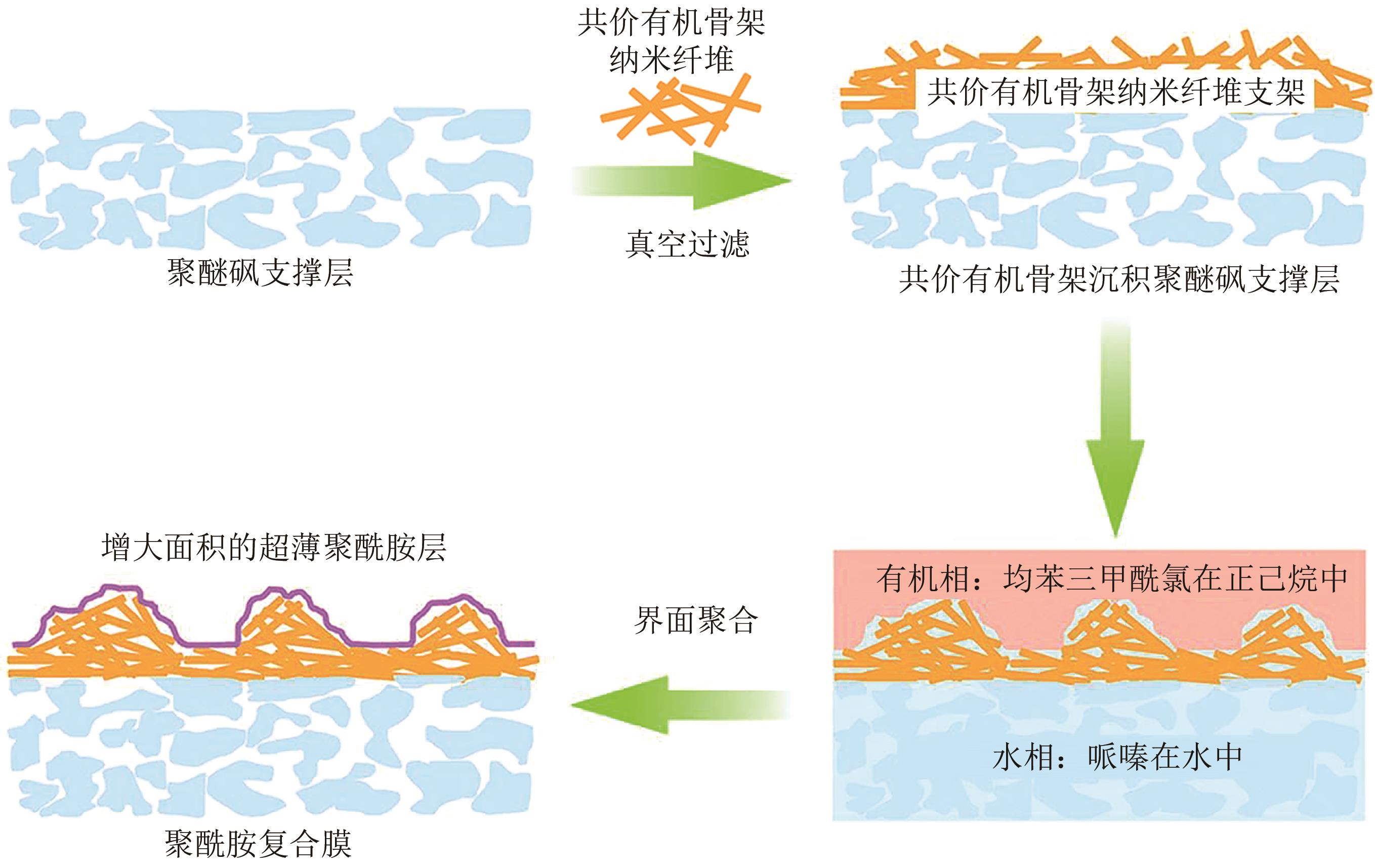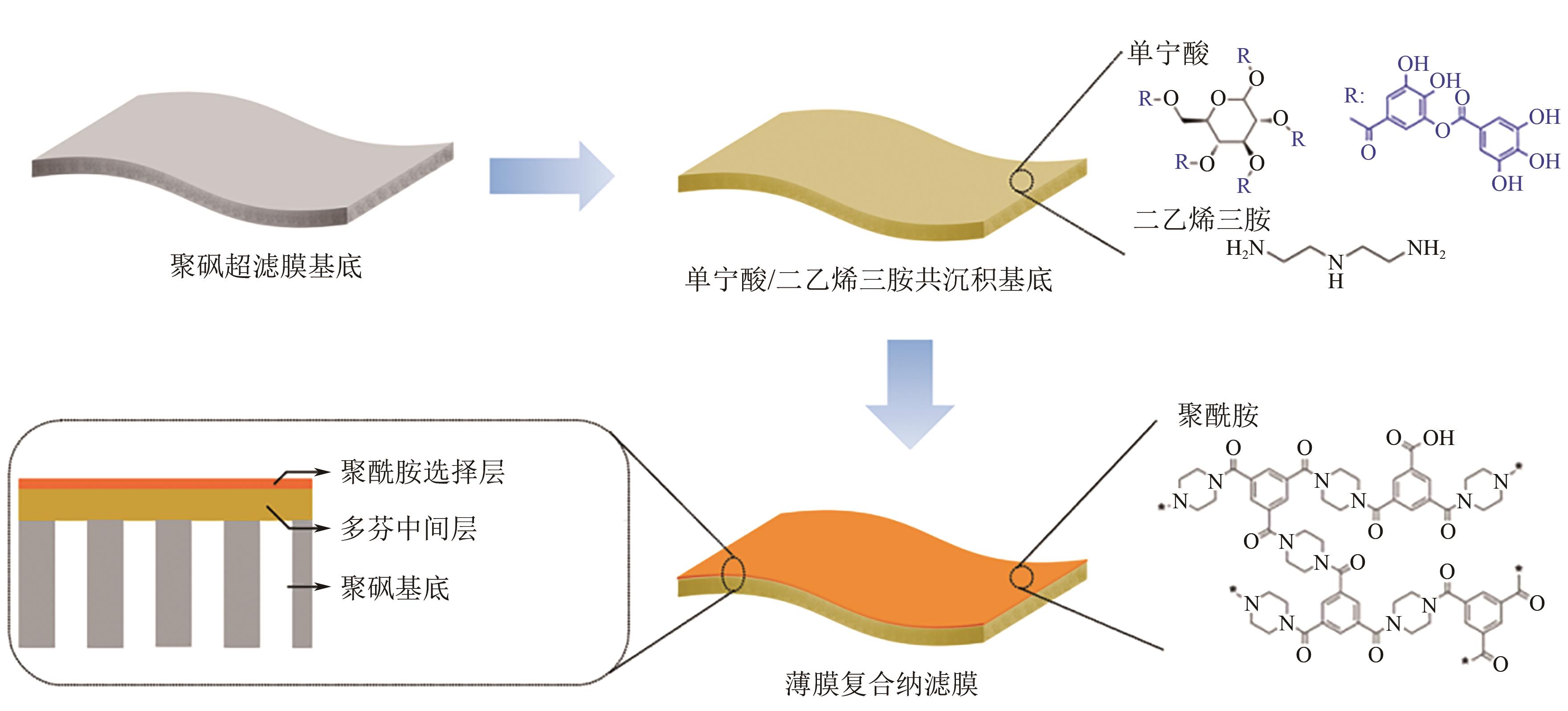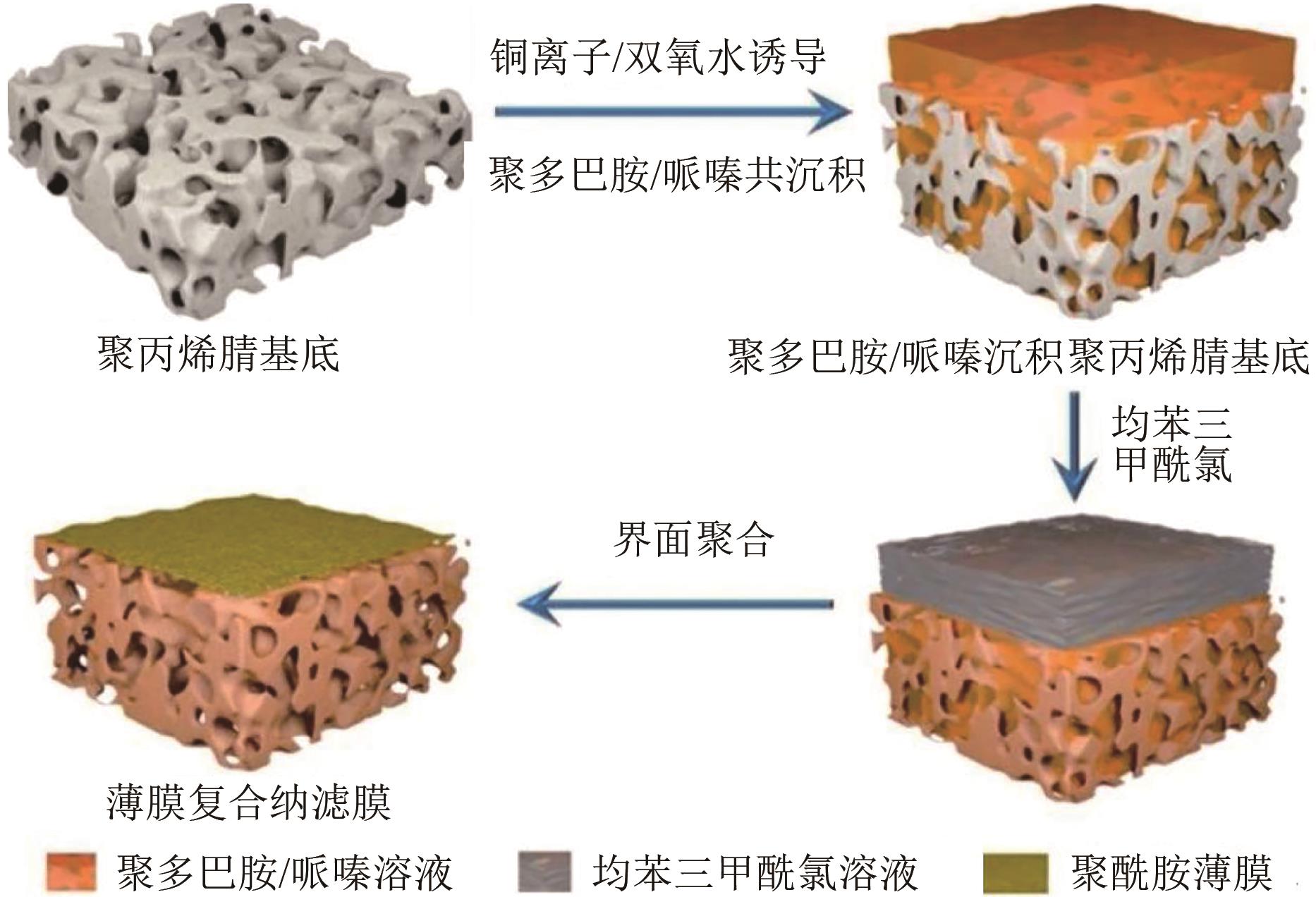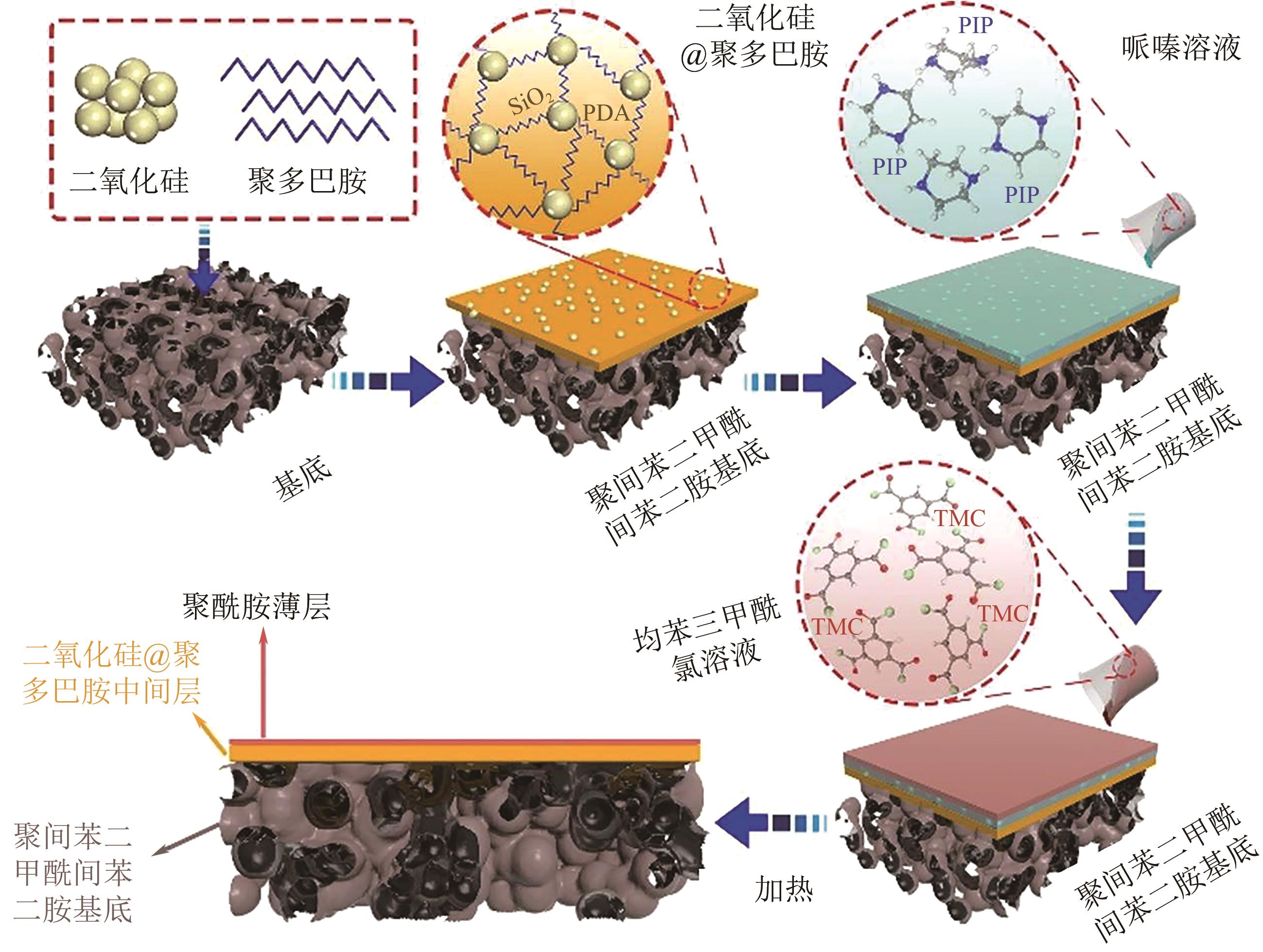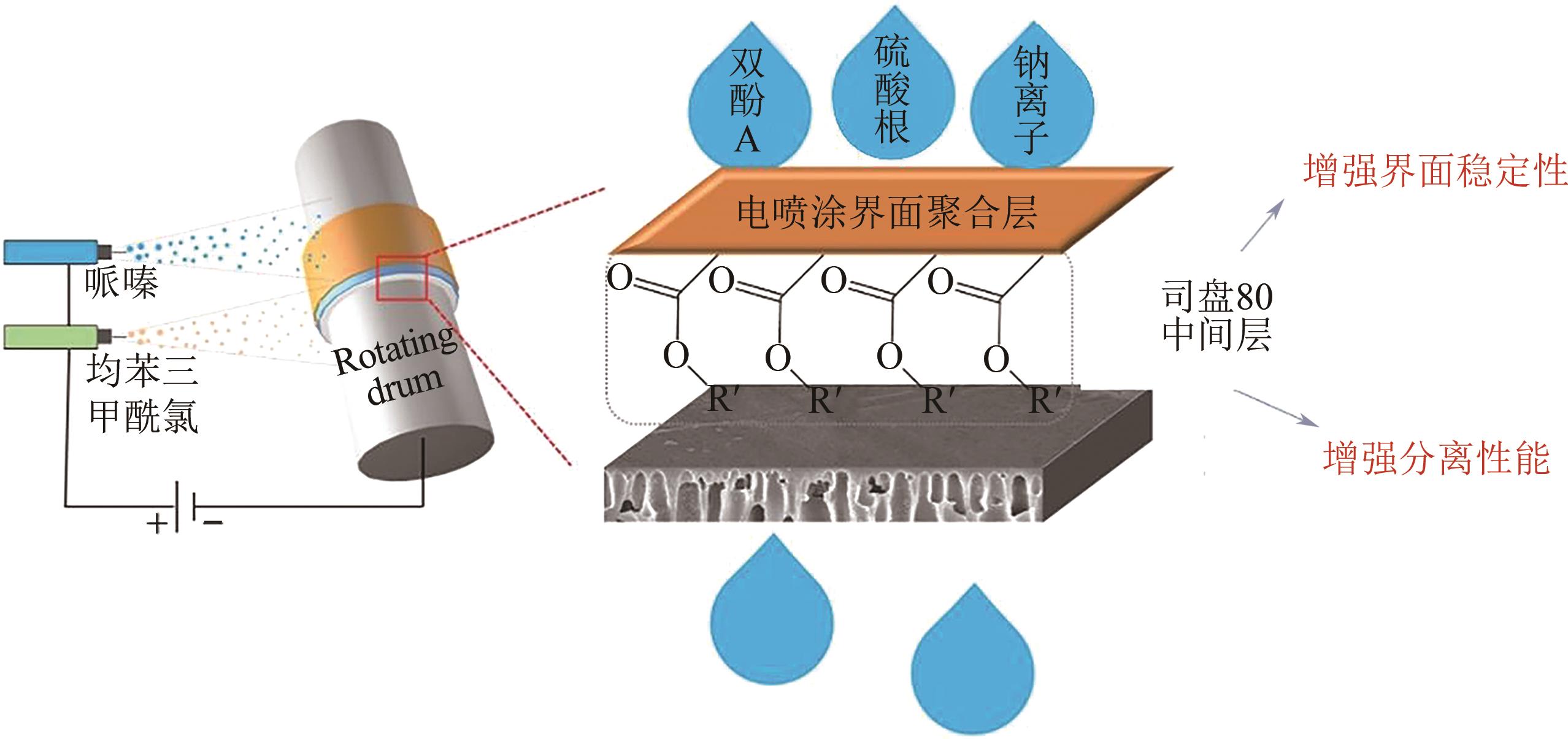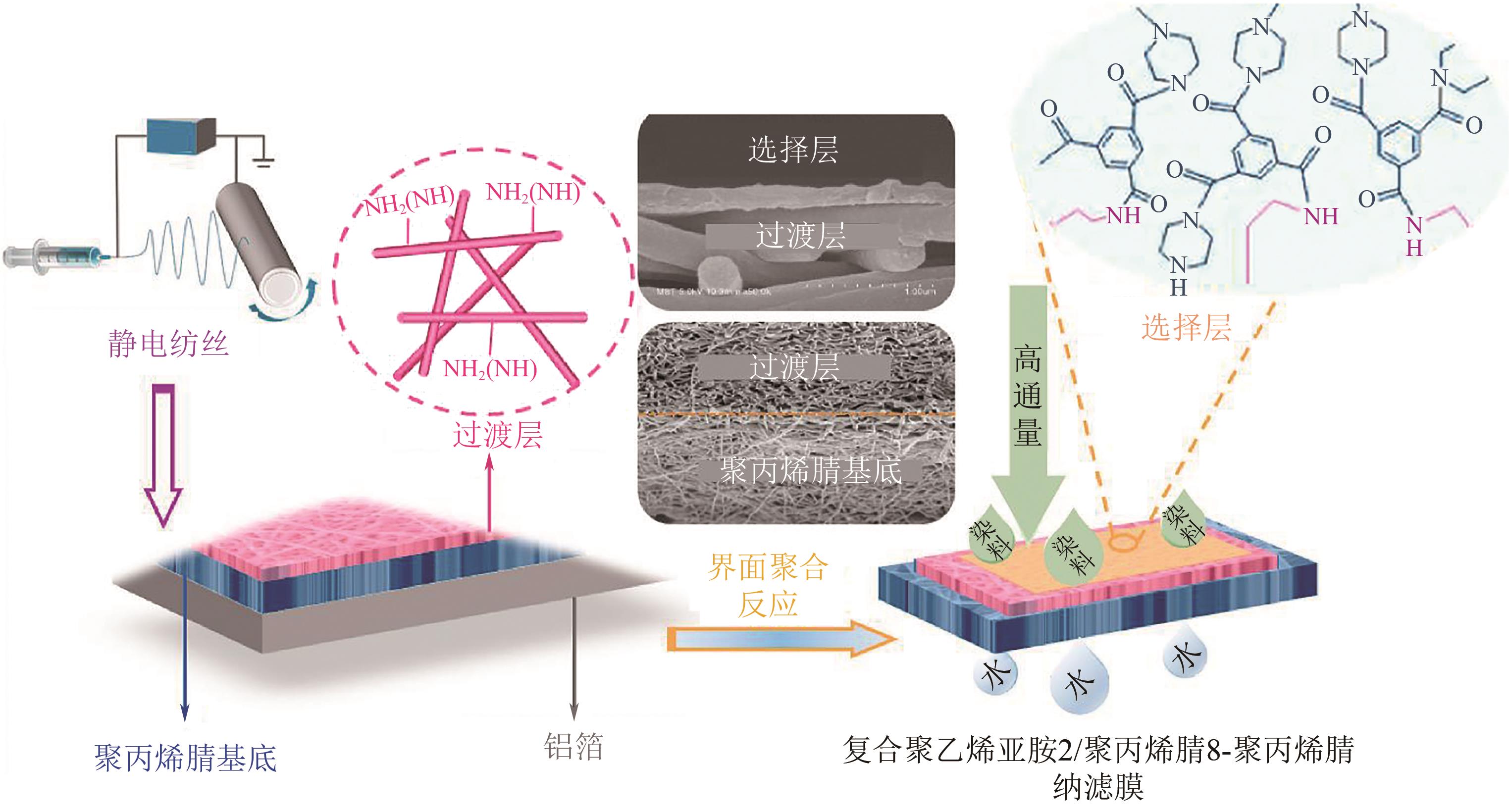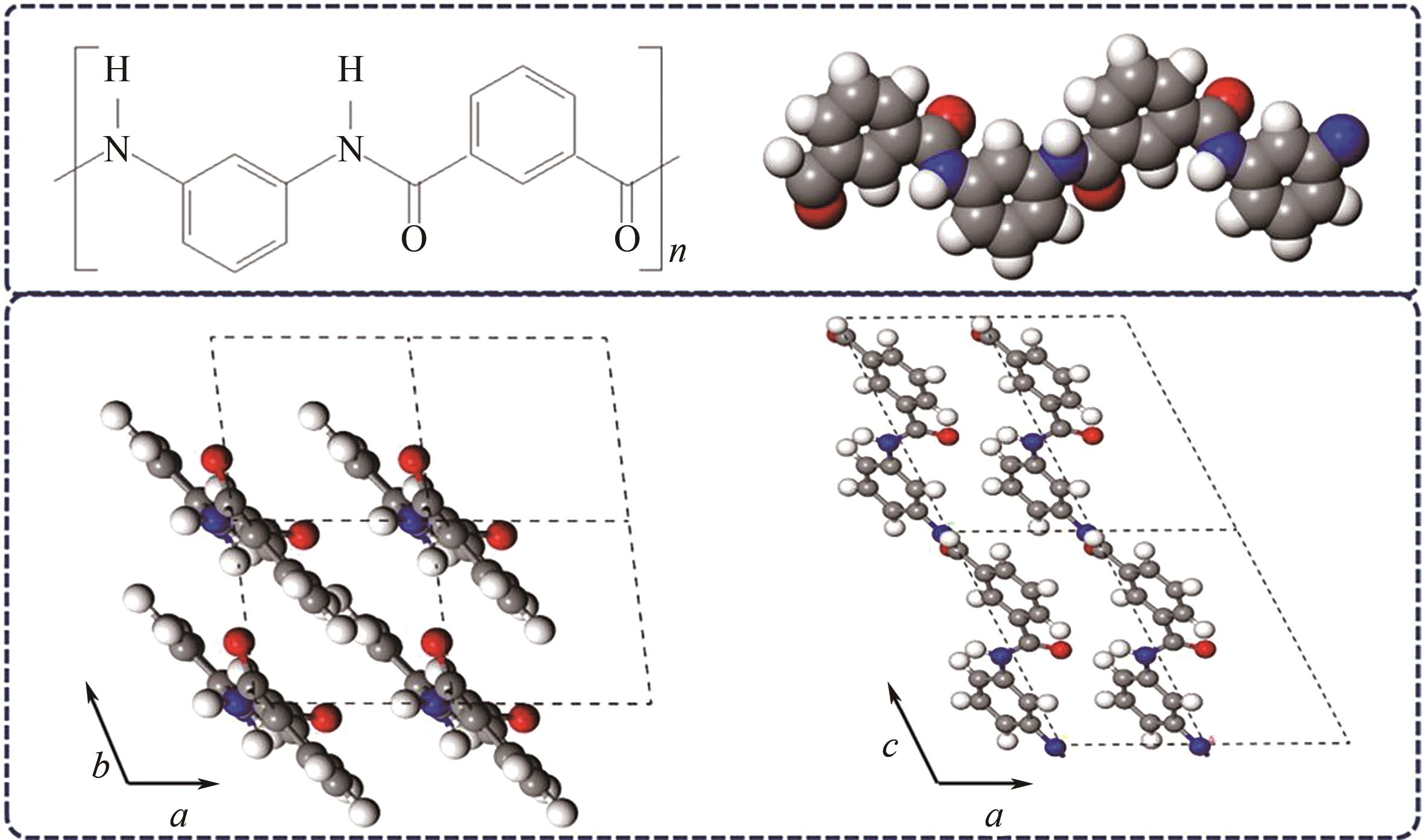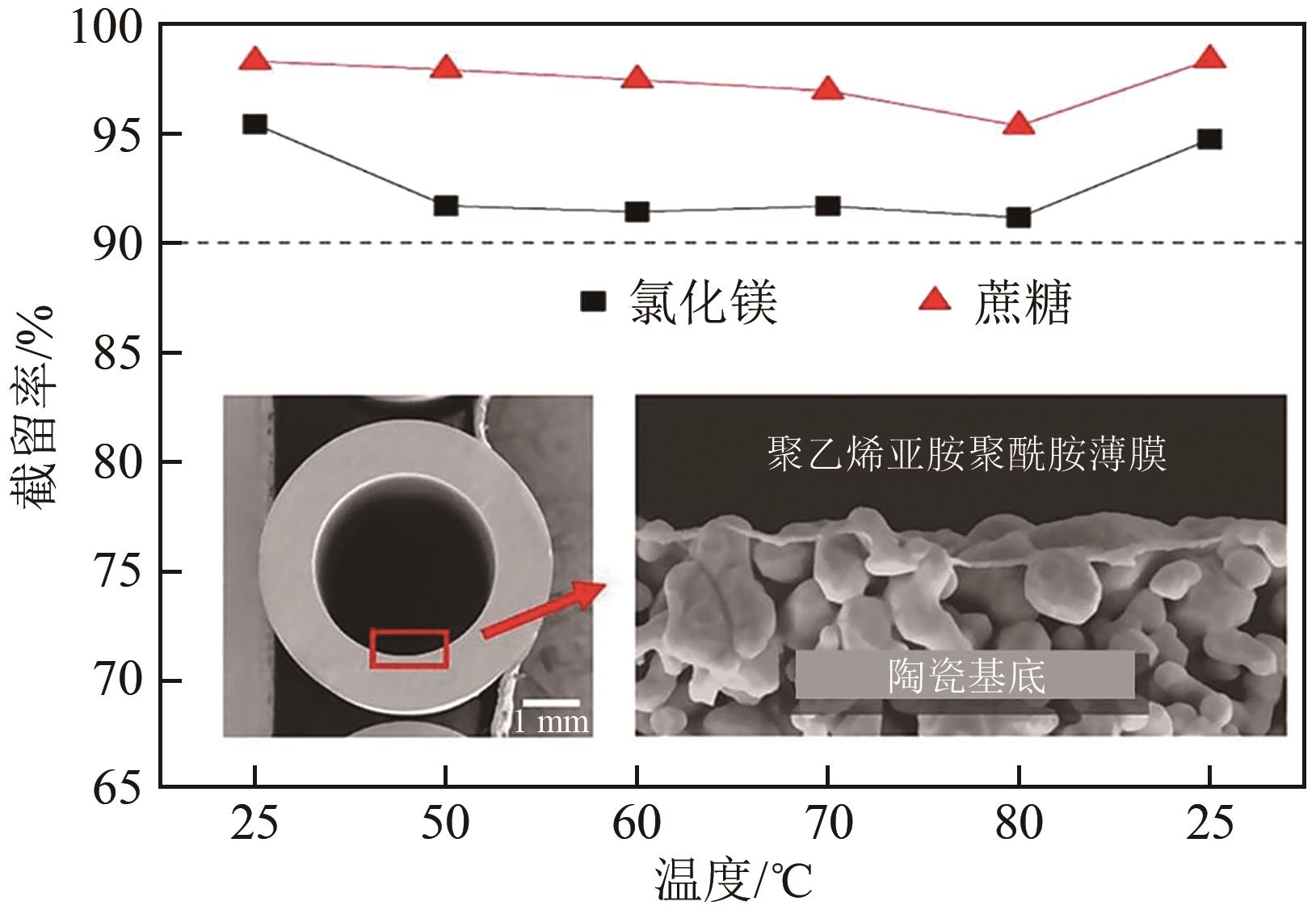化工进展 ›› 2023, Vol. 42 ›› Issue (4): 1917-1933.DOI: 10.16085/j.issn.1000-6613.2022-1082
聚酰胺复合膜微孔支撑基底的研究进展
赵珍珍1( ), 郑喜1, 王雪琪1, 王涛1(
), 郑喜1, 王雪琪1, 王涛1( ), 冯英楠1, 任永胜2, 赵之平1
), 冯英楠1, 任永胜2, 赵之平1
- 1.北京理工大学化学与化工学院,北京 102488
2.宁夏大学化学化工学院,省部共建煤炭高效利用与绿色化工 国家重点实验室,宁夏 银川 750021
-
收稿日期:2022-06-09修回日期:2022-07-26出版日期:2023-04-25发布日期:2023-05-08 -
通讯作者:王涛 -
作者简介:赵珍珍(1994—),女,硕士研究生,研究方向为纳滤复合薄膜。E-mail:2579376155@qq.com。 -
基金资助:国家重点研发计划(2021YFC2101202);省部共建煤炭高效利用与绿色化工国家重点实验室开放课题(2022-K57)
Research progress on microporous supporting substrate of polyamide composite membrane
ZHAO Zhenzhen1( ), ZHENG Xi1, WANG Xueqi1, WANG Tao1(
), ZHENG Xi1, WANG Xueqi1, WANG Tao1( ), FENG Yingnan1, REN Yongsheng2, ZHAO Zhiping1
), FENG Yingnan1, REN Yongsheng2, ZHAO Zhiping1
- 1.School of Chemistry and Chemical Engineering, Beijing Institute of Technology, Beijing 102488, China
2.State Key Laboratory of High-efficiency Utilization of Coal and Green Chemical Engineering, Department of Chemistry & Chemical Engineering, Ningxia University, Yinchuan 750021, Ninigxia, China
-
Received:2022-06-09Revised:2022-07-26Online:2023-04-25Published:2023-05-08 -
Contact:WANG Tao
摘要:
通过界面聚合法获得的聚酰胺复合膜在污废水处理、海水淡化等领域得到广泛应用,然而聚酰胺复合膜的结构对其应用起到关键作用,以往研究多数聚焦在分离层,而对复合膜微孔支撑基底的研究相对较少。研究表明,微孔基底的物化特征对于聚酰胺分离层结构的形成及复合膜性能起着至关重要的影响作用。为此,本文从支撑基底的制备工艺出发,围绕微孔基底的不同改性手段,介绍了传统基底改进方法和新型基底的材料与结构,并探讨了基底结构对压力驱动膜(纳滤、反渗透)与渗透压驱动膜(正渗透)分离层结构与性能的影响。分析表明,具有高孔隙率、亲水性好的微孔基底可有效调控界面聚合过程中单体的储存与扩散,有利于获得高渗透和高选择性能的聚酰胺复合膜。因此,未来仍需从聚合物材料及纳米改性等几个方面,发展更具潜力的微孔基底材料与结构,以推动聚酰胺复合膜的应用发展。
中图分类号:
引用本文
赵珍珍, 郑喜, 王雪琪, 王涛, 冯英楠, 任永胜, 赵之平. 聚酰胺复合膜微孔支撑基底的研究进展[J]. 化工进展, 2023, 42(4): 1917-1933.
ZHAO Zhenzhen, ZHENG Xi, WANG Xueqi, WANG Tao, FENG Yingnan, REN Yongsheng, ZHAO Zhiping. Research progress on microporous supporting substrate of polyamide composite membrane[J]. Chemical Industry and Engineering Progress, 2023, 42(4): 1917-1933.
| 1 | ZHANG Huiru, HE Qiming, LUO Jianquan, et al. Sharpening nanofiltration: strategies for enhanced membrane selectivity[J]. ACS Applied Materials & Interfaces, 2020, 12(36): 39948-39966. |
| 2 | WERBER J R, OSUJI C O, ELIMELECH M. Materials for next-generation desalination and water purification membranes[J]. Nature Reviews Materials, 2016, 1(5): 1-15. |
| 3 | AHMAD N A, GOH P S, ABDUL K Z, et al. Thin film composite membrane for oily waste water treatment: Recent advances and challenges[J]. Membranes, 2018, 8(4): E86. |
| 4 | CHONG C Y, LAU W J, YUSOF N, et al. Roles of nanomaterial structure and surface coating on thin film nanocomposite membranes for enhanced desalination[J]. Composites Part B: Engineering, 2019, 160: 471-479. |
| 5 | JI Chenhao, XUE Shuangmei, TANG Yongjian, et al. Polyamide membranes with net-like nanostructures induced by different charged mofs for elevated nanofiltration[J]. ACS Applied Polymer Materials, 2020, 2(2): 585-593. |
| 6 | WITTE P V, DIJKSTRA P J, FEIJEN J, et al. Phase separation processes in polymer solutions in relation to membrane formation[J]. Journal of Membrane Science, 1996, 117(1/2): 1-31. |
| 7 | MISDAN N, LAU W J, ISMAIL A F, et al. Formation of thin film composite nanofiltration membrane: Effect of polysulfone substrate characteristics[J]. Desalination, 2013, 329: 9-18. |
| 8 | SHARABATI J A D, GUCLU S, ERKOC-ILTER S, et al. Interfacially polymerized thin-film composite membranes: Impact of support layer pore size on active layer polymerization and seawater desalination performance[J]. Separation and Purification Technology, 2019, 212: 438-448. |
| 9 | SINGH P S, JOSHI S V, TRIVEDI J J, et al. Probing the structural variations of thin film composite RO membranes obtained by coating polyamide over polysulfone membranes of different pore dimensions[J]. Journal of Membrane Science, 2006, 278(1/2): 19-25. |
| 10 | ZHANG Qifeng, ZHANG Zhiguang, DAI Lei, et al. Novel insights into the interplay between support and active layer in the thin film composite polyamide membranes[J]. Journal of Membrane Science, 2017, 537: 372-383. |
| 11 | WAN Chunfeng, YANG Tianshi, GAI Wenxiao, et al. Thin-film composite hollow fiber membrane with inorganic salt additives for high mechanical strength and high power density for pressure-retarded osmosis[J]. Journal of Membrane Science, 2018, 555: 388-397. |
| 12 | HUANG L W, MCCUTCHEON J R. Impact of support layer pore size on performance of thin film composite membranes for forward osmosis[J]. Journal of Membrane Science, 2015, 483: 25-33. |
| 13 | MISDAN N, LAU W J, ISMAIL A F, et al. Study on the thin film composite poly(piperazine-amide) nanofiltration membrane: Impacts of physicochemical properties of substrate on interfacial polymerization formation[J]. Desalination, 2014, 344: 198-205. |
| 14 | SANAEEPUR H, AMOOGHIN A E, SHIRAZI M M, et al. Water desalination and ion removal using mixed matrix electrospun nanofibrous membranes: a critical review[J]. Desalination, 2022, 521: 115350. |
| 15 | CUI Jiaxin, LI Fanghua, WANG Yulin, et al. Electrospun nanofiber membranes for wastewater treatment applications[J]. Separation and Purification Technology, 2020, 250: 117116. |
| 16 | YOON K, HSIAO B S, CHU B. High flux nanofiltration membranes based on interfacially polymerized polyamide barrier layer on polyacrylonitrile nanofibrous scaffolds[J]. Journal of Membrane Science, 2009, 326(2): 484-492. |
| 17 | PARK M J, GONZALES R R, ABDEL-WAHAB A, et al. Hydrophilic polyvinyl alcohol coating on hydrophobic electrospun nanofiber membrane for high performance thin film composite forward osmosis membrane[J]. Desalination, 2018, 426: 50-59. |
| 18 | CHI Xiangyu, ZHANG Pingyun, GUO Xuejiao, et al. A novel TFC forward osmosis(FO) membrane supported by polyimide(PI) microporous nanofiber membrane[J]. Applied Surface Science, 2018, 427: 1-9. |
| 19 | Moon SON, Jiyeol BAE, PARK Hosik, et al. Continuous thermal-rolling of electrospun nanofiber for polyamide layer deposition and its detection by engineered osmosis[J]. Polymer, 2018, 145: 281-285. |
| 20 | ELSHERBINY I M, KHALIL A S, ULBRICHT M. Surface micro-patterning as a promising platform towards novel polyamide thin-film composite membranes of superior performance[J]. Journal of Membrane Science, 2017, 529: 11-22. |
| 21 | MARUF S H, GREENBERG A R, PELLEGRINO J, et al. Fabrication and characterization of a surface-patterned thin film composite membrane[J]. Journal of Membrane Science, 2014, 452: 11-19. |
| 22 | WON Y J, CHOI D C, JANG J H, et al. Factors affecting pattern fidelity and performance of a patterned membrane[J]. Journal of Membrane Science, 2014, 462: 1-8. |
| 23 | TIJING L D, DIZON J R, IBRAHIM I, et al. 3D printing for membrane separation, desalination and water treatment[J]. Applied Materials Today, 2020, 18: 100486. |
| 24 | MAZINANI Saeed, AL-SHIMMERY A, CHEW Y M, et al. 3D printed nanofiltration composite membranes with reduced concentration polarisation[J]. Journal of Membrane Science, 2022, 644: 120137. |
| 25 | GHOSH A K, HOEK E M. Impacts of support membrane structure and chemistry on polyamide-polysulfone interfacial composite membranes[J]. Journal of Membrane Science, 2009, 336(1/2): 140-148. |
| 26 | ZHU Shu, ZHAO Song, WANG Zhi, et al. Improved performance of polyamide thin-film composite nanofiltration membrane by using polyetersulfone/polyaniline membrane as the substrate[J]. Journal of Membrane Science, 2015, 493: 263-274. |
| 27 | NG D Y, WU B, CHEN Y F, et al. A novel thin film composite hollow fiber osmotic membrane with one-step prepared dual-layer substrate for sludge thickening[J]. Journal of Membrane Science, 2019, 575: 98-108. |
| 28 | PEYRAVI M, RAHIMPOUR A, JAHANSHAHI M. Thin film composite membranes with modified polysulfone supports for organic solvent nanofiltration[J]. Journal of Membrane Science, 2012, 423/424: 225-237. |
| 29 | OH N W, JEGAL J, LEE K H. Preparation and characterization of nanofiltration composite membranes using polyacrylonitrile (PAN). Ⅱ. Preparation and characterization of polyamide composite membranes[J]. Journal of Applied Polymer Science, 2001, 80(14): 2729-2736. |
| 30 | Liliana PÉREZ-MANRÍQUEZ, Jamaliah ABURABI’E, NEELAKANDA Pradeep, et al. Cross-linked PAN-based thin-film composite membranes for non-aqueous nanofiltration[J]. Reactive and Functional Polymers, 2015, 86: 243-247. |
| 31 | KIM H I, KIM S S. Plasma treatment of polypropylene and polysulfone supports for thin film composite reverse osmosis membrane[J]. Journal of Membrane Science, 2006, 286(1/2): 193-201. |
| 32 | ONG C S, AL-ANZI B, LAU W J, et al. Anti-fouling double-skinned forward osmosis membrane with zwitterionic brush for oily wastewater treatment[J]. Scientific Reports, 2017, 7(1): 1-11. |
| 33 | PARK S H, KWON S J, SHIN M G, et al. Polyethylene-supported high performance reverse osmosis membranes with enhanced mechanical and chemical durability[J]. Desalination, 2018, 436: 28-38. |
| 34 | KARAN S, JIANG Z W, LIVINGSTON A G. Sub-10nm polyamide nanofilms with ultrafast solvent transport for molecular separation[J]. Science, 2015, 348(6241): 1347-1351. |
| 35 | GONG Genghao, WANG Ping, ZHOU Zongyao, et al. New insights into the role of an interlayer for the fabrication of highly selective and permeable thin-film composite nanofiltration membrane[J]. ACS Applied Materials & Interfaces, 2019, 11(7): 7349-7356. |
| 36 | WANG Yajun, WANG Tao, LI Shenhui, et al. Novel poly(piperazinamide)/poly(m-phenylene isophthalamide) composite nanofiltration membrane with polydopamine coated silica as an interlayer for the splendid performance[J]. Separation and Purification Technology, 2022, 285: 120390. |
| 37 | ZHANG Zhe, SHI Xiansong, WANG Rui, et al. Ultra-permeable polyamide membranes harvested by covalent organic framework nanofiber scaffolds: a two-in-one strategy[J]. Chemical Science, 2019, 10(39): 9077-9083. |
| 38 | ZHOU Zongyao, HU Yunxia, Chanhee BOO, et al. High-performance thin-film composite membrane with an ultrathin spray-coated carbon nanotube interlayer[J]. Environmental Science & Technology Letters, 2018, 5(5): 243-248. |
| 39 | BI Ran, ZHANG Qi, ZHANG Runnan, et al. Thin film nanocomposite membranes incorporated with graphene quantum dots for high flux and antifouling property[J]. Journal of Membrane Science, 2018, 553: 17-24. |
| 40 | WANG Jingjing, YANG Haocheng, WU Mingbang, et al. Nanofiltration membranes with cellulose nanocrystals as an interlayer for unprecedented performance[J]. Journal of Materials Chemistry A, 2017, 5(31): 16289-16295. |
| 41 | SMITH E D, HENDREN K D, HAAG J V, et al. Functionalized cellulose nanocrystal nanocomposite membranes with controlled interfacial transport for improved reverse osmosis performance[J]. Nanomaterials (Basel, Switzerland), 2019, 9(1): 125. |
| 42 | BAI Langming, DING Junwen, WANG Haorui, et al. High-performance nanofiltration membranes with a sandwiched layer and a surface layer for desalination and environmental pollutant removal[J]. Science of the Total Environment, 2020, 743: 140766. |
| 43 | SHI Mengqi, YAN Wentao, ZHOU Yong, et al. Combining tannic acid-modified support and a green co-solvent for high performance reverse osmosis membranes[J]. Journal of Membrane Science, 2020, 595: 117474. |
| 44 | ZHANG Xi, LV Yan, YANG Haocheng, et al. Polyphenol coating as an interlayer for thin-film composite membranes with enhanced nanofiltration performance[J]. ACS Applied Materials & Interfaces, 2016, 8(47): 32512-32519. |
| 45 | LI Yafei, SU Yanlei, LI Jianyu, et al. Preparation of thin film composite nanofiltration membrane with improved structural stability through the mediation of polydopamine[J]. Journal of Membrane Science, 2015, 476: 10-19. |
| 46 | ZHU Junyong, YUAN Shushan, ULIANA Adam, et al. High-flux thin film composite membranes for nanofiltration mediated by a rapid co-deposition of polydopamine/piperazine[J]. Journal of Membrane Science, 2018, 554: 97-108. |
| 47 | YANG Simin, WANG Jianqiang, FANG Lifeng, et al. Electrosprayed polyamide nanofiltration membrane with intercalated structure for controllable structure manipulation and enhanced separation performance[J]. Journal of Membrane Science, 2020, 602: 117971. |
| 48 | YANG Yin, LI Xiong, SHEN Lingdi, et al. A durable thin-film nanofibrous composite nanofiltration membrane prepared by interfacial polymerization on a double-layer nanofibrous scaffold[J]. RSC Advances, 2017, 7(29): 18001-18013. |
| 49 | JU Xiaohui, LU Jinpeng, ZHAO Liulin, et al. Electrospun transition layer that enhances the structure and performance of thin-film nanofibrous composite membranes[J]. Journal of Membrane Science, 2021, 620: 118927. |
| 50 | ZHANG Luyao, SHI Yingxian, WANG Tao, et al. Fabrication of novel anti-fouling poly(m-phenylene isophthalamide) ultrafiltration membrane modified with pluronic F127 via coupling phase inversion and surface segregation[J]. Separation and Purification Technology, 2022, 282: 120106. |
| 51 | WANG Tao, ZHENG Xi, WANG Yajun, et al. Fabrication and performance of novel poly(piperazine-amide) composite nanofiltration membranes based on various poly(m-phenylene isophthalamide) substrates[J]. Industrial & Engineering Chemistry Research, 2021, 60(49): 18106-18120. |
| 52 | WANG Tao, HE Xinping, LI Ye, et al. Novel poly(piperazine-amide) (PA) nanofiltration membrane based poly(m-phenylene isophthalamide) (PMIA) hollow fiber substrate for treatment of dye solutions[J]. Chemical Engineering Journal, 2018, 351: 1013-1026. |
| 53 | CHEN Mingxing, XIAO Changfa, WANG Chun, et al. Preparation and characterization of a novel thermally stable thin film composite nanofiltration membrane with poly(m-phenyleneisophthalamide) (PMIA) substrate[J]. Journal of Membrane Science, 2018, 550: 36-44. |
| 54 | QIU Zelin, YU Wenhan, SHEN Yujie, et al. Cationic hyperbranched poly(amido-amine) engineered nanofiltration membrane for molecular separation[J]. Journal of Membrane Science, 2021, 629: 119275. |
| 55 | AL‐MUSAWY W K, AL‐FURAIJI M H, ALSALHY Q F. Synthesis and characterization of PVC-TFC hollow fibers for forward osmosis application[J]. Journal of Applied Polymer Science, 2021, 138(35): 50871. |
| 56 | IRANIZADEH S T, CHENAR M P, MAHBOUB M N, et al. Preparation and characterization of thin-film composite reverse osmosis membrane on a novel aminosilane-modified polyvinyl chloride support[J]. Brazilian Journal of Chemical Engineering, 2019, 36(1): 251-264. |
| 57 | ZHENG Ke, ZHOU Shaoqi, CHENG Zuqin, et al. Polyvinyl chloride/quaternized poly phenylene oxide substrates supported thin-film composite membranes: Enhancement of forward osmosis performance[J]. Journal of Membrane Science, 2021, 623: 119070. |
| 58 | YANG Fajie, ZHANG Shouhai, YANG Daling, et al. Preparation and characterization of polypiperazine amide/ppesk hollow fiber composite nanofiltration membrane[J]. Journal of Membrane Science, 2007, 301(1/2): 85-92. |
| 59 | LI Jinzhen, HU Yang, LIU Wei, et al. High flux and hydrophilic fibrous ultrafiltration membranes based on electrospun titanium dioxide nanoparticles/polyethylene oxide/poly(vinylidene fluoride) composite scaffolds[J]. Journal of Nanoscience and Nanotechnology, 2017, 17(12): 9042-9049. |
| 60 | LAI G S, LAU W J, GOH P S, et al. Graphene oxide incorporated thin film nanocomposite nanofiltration membrane for enhanced salt removal performance[J]. Desalination, 2016, 387: 14-24. |
| 61 | PAN Shufang, KE Xiaoxue, WANG Tingyu, et al. Synthesis of silver nanoparticles embedded electrospun PAN nanofiber thin-film composite forward osmosis membrane to enhance performance and antimicrobial activity[J]. Industrial & Engineering Chemistry Research, 2019, 58(2): 984-993. |
| 62 | TIAN Miao, WANG Yining, WANG Rong, et al. Synthesis and characterization of thin film nanocomposite forward osmosis membranes supported by silica nanoparticle incorporated nanofibrous substrate[J]. Desalination, 2017, 401: 142-150. |
| 63 | SON M, CHOI H G, LIU L, et al. Efficacy of carbon nanotube positioning in the polyethersulfone support layer on the performance of thin-film composite membrane for desalination[J]. Chemical Engineering Journal, 2015, 266: 376-384. |
| 64 | XIA Lingling, REN Jian, WEYD Marcus, et al. Ceramic-supported thin film composite membrane for organic solvent nanofiltration[J]. Journal of Membrane Science, 2018, 563: 857-863. |
| 65 | CHONG J Y, WANG R. From micro to nano: polyamide thin film on microfiltration ceramic tubular membranes for nanofiltration[J]. Journal of Membrane Science, 2019, 587: 117161. |
| 66 | LI Yuxuan, CAO Yue, WANG Ming, et al. Novel high-flux polyamide/TiO2 composite nanofiltration membranes on ceramic hollow fibre substrates[J]. 2018, 565: 322-330. |
| 67 | ZHOU Zongyao, LU Dongwei, LI Xiang, et al. Fabrication of highly permeable polyamide membranes with large “leaf-like” surface nanostructures on inorganic supports for organic solvent nanofiltration[J]. 2020, 601: 117932. |
| [1] | 张赛晖, 李校阳, 高慧, 王丽丽. 制备聚酰胺复合膜中界面聚合反应添加剂研究进展[J]. 化工进展, 2022, 41(9): 4884-4894. |
| [2] | 李泽辉, 崔恒, 王军. 氯化聚氯乙烯复合纳滤膜的制备及其在模拟RB5染料废水处理中的应用[J]. 化工进展, 2021, 40(S1): 456-465. |
| [3] | 刘娟, 陈宇昊, 叶海星, 孙海翔. 界面聚合在渗透汽化膜分离领域的应用进展[J]. 化工进展, 2021, 40(8): 4314-4326. |
| [4] | 刘祎, 汪明旺, 吕宏凌, 陈金庆. 共价有机骨架聚合物功能膜制备方法的研究进展[J]. 化工进展, 2021, 40(8): 4360-4370. |
| [5] | 陈宇昊, 刘家辉, 刘娟, 章洪斌, 孙海翔. 新型复合纳滤膜研究进展[J]. 化工进展, 2021, 40(5): 2665-2675. |
| [6] | 秘一芳, 安全福. 界面聚合聚酰胺纳滤膜渗透选择性能优化的研究进展[J]. 化工进展, 2020, 39(6): 2093-2104. |
| [7] | 邢雅南, 苏保卫, 甄宏艳. 耐溶剂纳滤膜的制备与应用研究进展[J]. 化工进展, 2015, 34(11): 3832-3840. |
| [8] | 孙志猛1,2,任晓晶2,赵可卉2,张忠国2,赵义平1,陈 莉1,程言君2. 耐污染聚酰胺复合纳滤膜的制备及性能[J]. 化工进展, 2012, 31(05): 1088-1095. |
| [9] | 石 磊,包宗宏. 阻燃剂微胶囊化的研究进展 [J]. 化工进展, 2008, 27(7): 1001-. |
| [10] | 张景亚,张浩勤,谭翎燕,乔欢欢,刘金盾. 正交实验法优化制备复合荷电镶嵌膜 [J]. 化工进展, 2008, 27(12): 1996-. |
| [11] | 杨文川,褚良银,庞雪芹,巨晓洁. 磁性温度感应微囊膜的制备与表征 [J]. 化工进展, 2008, 27(1): 120-. |
| [12] | 庄秋虹,张正国,方晓明. 微/纳米胶囊相变材料的制备及应用进展 [J]. 化工进展, 2006, 25(4): 388-. |
| [13] | 崔绍波,卢忠远,刘德春,王文忠,肖相齐,宋丽贤. 界面聚合技术及其应用研究进展 [J]. 化工进展, 2006, 25(1): 47-. |
| 阅读次数 | ||||||
|
全文 |
|
|||||
|
摘要 |
|
|||||
